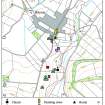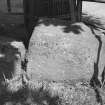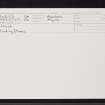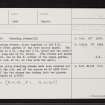Rhynie
Standing Stone(S) (Prehistoric)
Site Name Rhynie
Classification Standing Stone(S) (Prehistoric)
Alternative Name(s) Rhynie, Free Church Manse; Rhynie, The Square; Rhynie Square
Canmore ID 17186
Site Number NJ42NE 23
NGR NJ 4989 2709
NGR Description Removed to NJ 4987 2710
Datum OSGB36 - NGR
Permalink http://canmore.org.uk/site/17186
- Council Aberdeenshire
- Parish Rhynie
- Former Region Grampian
- Former District Gordon
- Former County Aberdeenshire
NJ42NE 23 4989 2709 removed to 4987 2710.
(NJ 4990 2708) Standing Stones (NR)
OS 25" map, Aberdeenshire, (1902)
Two standing stones, close together at the NE corner of the front garden of the free church manse. The southern stone is 4ft long and 2ft broad and the northern is 3ft long and 1 1/2ft broad. (The stones are shown on OS 25" map, Aberdeenshire, 1866, one at the N corner of the manse garden, and the other SE of it, in line with the wall).
Name Book 1866.
These two plain standing stones have been removed and re-erected at the SE end of the square, at NJ 4988 2710. The larger of the two stones has broken into two pieces.
Re-surveyed at 1/2500.
Visited by OS (NKB) 3 October 1967.
Two small standing stones, which originally stood at the NE corner of the garden of the Free Church manse, now flank the SE gate of Rhynie Square. That to the W has a pointed profile, and measures 0.6m in breadth by 0.35m in thickness and 0.9m in height. That to the E is more rounded, measuring 0.5m in breadth by 0.42m in thickness and 0.75m in height.
Visited by RCAHMS (JRS, IF), 6 May 1996.
Excavation
NJ 4985 2702 A small test pit was opened around Rhynie No.3 (NJ42NE 22.02) measuring c.1 x 1 m and 0.3 m deep to expose the possible symbol carvings at the base of the human figure (Figure 2 and 3). The trench was opened by hand using a spade with plastic tools used in the immediate vicinity of the carved face on the southwest side of the stone to minimise any chance of damage. Soft brushes were used to remove any remaining soil around the face of the stone to allow recording of the stone face using digital recording techniques. These techniques included conventional digital SLR photography and photogrammetry.
The digital recording revealed new detail regarding the human figure and a possible symbol below their feet.
Archive: University of Aberdeen
Funder: University of Aberdeen and Historic Environment Scotland
Gordon Noble and James O’Driscoll - University of Aberdeen
(Source: DES Vol 20)


















